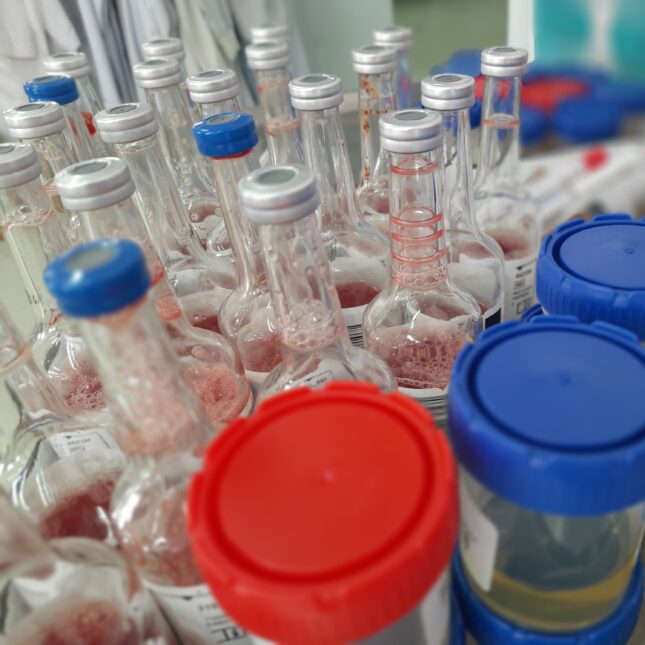
Hospitals across the country are facing a severe shortage of supplies of blood culture bottles, critical tools for diagnosing serious and sometimes life-threatening bloodstream infections.
The Centers for Disease Control and Prevention sent out an alert Tuesday to health care providers, laboratory professionals, health care facility administrators, and state, tribal, local, and territorial health departments warning of the shortage of Bactec blood culture medium bottles, marketed by Becton Dickinson. The shortage, which has been going on for weeks, could stretch into September, hospitals have been warned.
The blood culture bottles are a basic part of a health care provider’s effort to figuring out what is causing a bloodstream infection and determining how to treat it, Krutika Kuppalli, an infectious diseases specialist and a spokesperson for the Infectious Diseases Society of America, told STAT in an email. Bacteria such as Staphylococcus aureus can cause bloodstream infections.
“Without the ability to identify pathogens or [their susceptibility to specific antibiotics], patients may remain on broad antibiotics, increasing the risk of antibiotic resistance and Clostridium difficile-associated diarrhea,” Kuppalli said. “Shortages may also discourage ordering blood cultures, leading to missed infections that need treatment.”
In a Zoom webinar hosted by the CDC and the IDSA, speakers from hospitals that have been dealing with the shortage talked about the impact of the shortfall of supplies. Several warned that some institutions may run out of the bottles entirely. Romney Humphries, medical director of the microbiology laboratory at Vanderbilt University Medical Center in Nashville, said when her 1,700 bed hospital received its shipment this week, it contained 10 bottles.
“This situation is not a good thing for patients,” she said.
Humphries and other experts on the call talked about the steps hospitals are taking to try to safely reduce the number of blood culture tests they run to preserve critical supplies, things like exploring whether expired bottles could safely be used, and barring repeat cultures within 48 hours, except when absolutely necessary. She said that the stewardship measures the hospital had put in place near the end of June have reduced their use of the scarce blood culture bottles by about 58%.
Sarah Turbett, associate director of clinical microbiology laboratories at Massachusetts General Hospital in Boston, said hospitals need to return to best practices, reminding staff not to order unnecessary tests. Some institutions are going to need to think about moving to rationing of the tests, she said, noting some hospitals already have.
Turbett said her team tested some BD blood culture bottles that were about 100 days past their expiration date to see if they were still able to detect pathogens with the same efficacy as bottles that had not yet expired; they saw no difference in the time to bacterial growth — needed to detect the cause of an infection — in the expired bottles when compared to bottles that had not expired. The work, she said, was inspired by a recent letter to the Journal of Clinical Microbiology and Infection that reported blood culture bottles were stable for between four and seven months after their expiration dates. The letter, from European scientists, was based on a study of a different brand of blood culture bottles.
But when attendees on the call asked whether the Food and Drug Administration would allow use of expired blood culture bottles, a representative of the agency was not able to provide an immediate answer.
“The reality of the situation is you can’t let perfect be the enemy of good,” Turbett said of this and other usage reducing techniques hospitals are putting in place to try to make it through this shortage.
Chris Beddard, BD’s vice president of microbiology, told the meeting that the company uses a single supplier of the Bactec blood culture bottles. The supplier, which she did not name, has reliably produced the product for BD for 12 years, she said.
Blood cultures are run in many circumstances — some of them unnecessary, Andrew Pavia, chief of pediatric infectious diseases at the University of Utah, told STAT in an email. But in others, knowing what is the cause of a bloodstream infection and which antibiotics it will respond to is key to successful treatment.
“There are conditions like uncomplicated community acquired pneumonia or skin infections where blood cultures are often obtained (in spite of guidelines) but add very little. It will be critical though that blood cultures are obtained from patients with sepsis, those likely to have bloodstream infections, and very vulnerable patients,” he said.
Asked if doctors could find themselves flying blind as they try to treat bloodstream infections, Pavia said he didn’t think that will be the situation in most cases, “but the windscreen may be dirty.”
“It will require care, thought and flexibility,” he said. “And of course, the shortage could be worse than forecast, and then things could become more scary.”
To submit a correction request, please visit our Contact Us page.











STAT encourages you to share your voice. We welcome your commentary, criticism, and expertise on our subscriber-only platform, STAT+ Connect